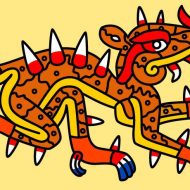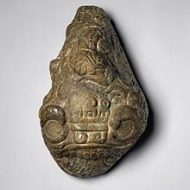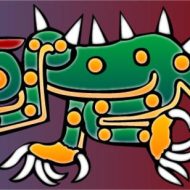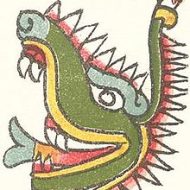Cipactli : The Insatiable Crocodile
Listen
At a glance
| Description | |
|---|---|
| Origin | Aztec Mythology |
| Classification | Animals |
| Family Members | N/A |
| Region | Mexico |
| Associated With | Earth, Volcanoes, Sacrifice |
Cipactli
Introduction
Cipactli is one of the major characters in Aztec mythology. In Aztec cosmology, the crocodile represents the earth floating in the primeval waters. This animal was named after a survivor of the flood, Tecocipactli or the Divine Crocodile who lived in a canoe and later repopulated the earth.
The Cipactli is also quite heavily featured in Mayan mythology and it is also considered to have heavily influenced the much later civilizations of the region.
Physical Traits
Cipactli was a primeval sea monster, part crocodilian, part fish, and part toad or frog, with indefinite gender. Always hungry, every joint on its body was adorned with an extra mouth. The deity Tezcatlipoca sacrificed a foot when he used it as bait to draw the monster nearer. He and Quetzalcoatl created the earth from its body.
Other Names
In the Maya tzolko’in, the name Cipactli translates to Imix. In the Popol Vuh, the earthquake demon Sipakna is named after Cipactli. In Migan, Cipactli is Quanai.
Powers and Abilities
This animal had an insatiable hunger which threatened to devour ever creation on earth. The existence of multiple mouths also ensured that this consumption was at a rapid pace.
Historical influence
To counter the effects of this beast, the gods then decided to kill it and use its body as land. Tezcatlipoca lured the monster in and lost a foot to its insatiable appetite before the gods were able to defeat it. They pulled Cipactli’s body in four directions and freed the universe from its body.
Then Tezcatlipoca and Quetzalcoatl created the heavens and the Earth from the remains. The thirteen heavens were made from the head, its tail became the underworld and it’s midsection the Earth. Its four legs became the four rain gods, Tlāloc, Chalchiuhtlicue, Huixtocihuatl, and Chicomecōātl.
Despite this, Cipactli was still alive and the gods promised him/her regular blood sacrifices. When these sacrifices were disrupted, it is believed that the beast expressed his displeasure via earthquakes and volcanic eruptions.
Related Images
Frequently Asked Questions
What is Cipactli the god of?
Cipactli is not technically a god but is often used to symbolise new beginings and the creation of the earth.
What powers did cipactli have?
This animal had an insatiable hunger which threatened to devour ever creation on earth. The existence of multiple mouths also ensured that this consumption was at a rapid pace.
Is Cipactli Aztec or Mayan?
Cipactli is one of the major characters in Aztec mythology. The Cipactli is also quite heavily featured in Mayan mythology and it is also considered to have heavily influenced the much later civilizations of the region.
What are other names for Cipactli?
Cipactli was also referred to as Imix.
Why did the gods kill Cipactli?
The gods realized that all their creations would eventually fall into the void and be consumed by Cipactli, and they decided to destroy it.









